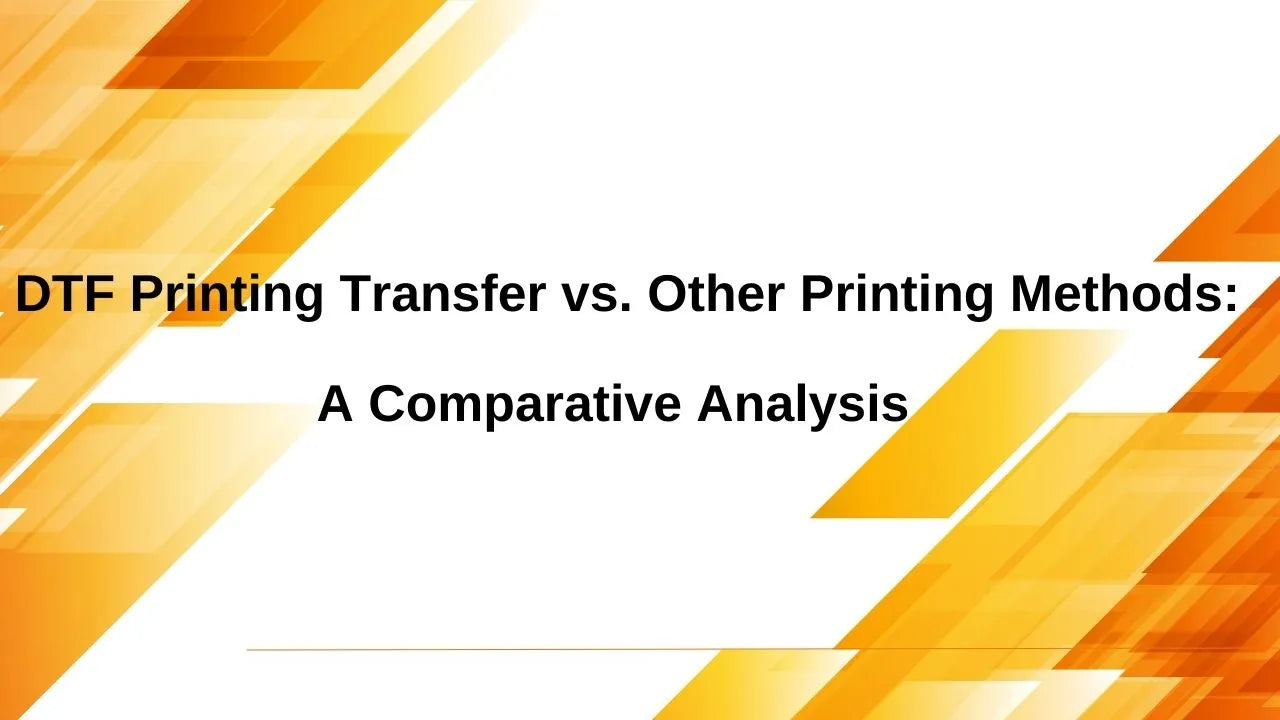
The Role of DTF Print Quality in Achieving Smooth Results
The textile industry is witnessing a revolution with the advent of Direct to Film (DTF) printing technology, raising the bar for print quality and consistency. Achieving smooth printing results hinges on the precision and clarity inherent in DTF print quality. As the market for personalized and short-run textile printing grows, the demand for high-caliber direct to film printing quality is at an all-time high. Professionals in textile printing understand that the success of their products in a competitive market depends on the flawless application of vibrant designs onto a range of fabrics.
Key Takeaways
- DTF print quality significantly influences the smoothness and clarity of final textile products.
- Advanced direct to film printing technology provides superior quality over traditional textile printing methods.
- Consistency in DTF print quality is paramount for meeting consumer expectations in the fast-paced fashion industry.
- The right balance of ink, heat, and pressure ensure vibrant results that stand the test of time.
- Investing in high-quality DTF printing processes can lead to increased customer satisfaction and business growth.
- Attention to detail in every step of the DTF process translates to textiles that impress both visually and tactilely.
Understanding DTF Printing Technology
The advent of Direct to Film (DTF) printing marks a significant milestone in the textile industry, changing the dynamics of fabric decoration. Rooted in innovation, the DTF Printing Evolution continues to unfold, guiding the transition from conventional methods to a technology-rich future. As businesses adopt DTF, understanding its development and core technology becomes imperative.
History and Evolution of DTF Printing
DTF's inception emerged from the need to simplify and enhance textile printing processes. It has since transcended its preliminary form, becoming a sophisticated choice for detailed and durable fabric design. The Direct to Film Printing Development has been particularly noteworthy, embracing digital advancements to facilitate quicker, more adaptive, and eco-friendlier production. Over the years, DTF has blossomed into a versatile printing method, appreciated for its ability to deliver high-quality results across various fabric types.
Key Components of the DTF Printing Process
To grasp the essence of DTF, one must dissect its primary elements. Each of the DTF Technology Components plays a pivotal role in achieving the spectacular print quality that defines the method. This includes specialized films designed to receive and transfer inks, high-grade inks that provide the vivid hues, cutting-edge printers finely engineered for precision, and premium powder adhesives that ensure the inks adhere to the textiles securely. Collectively, these components represent the innovation and efficiency at the heart of DTF printing technology.
Essential Factors in High-Quality DTF Printing
The pursuit of High-Quality DTF Printing is not unlike mastering a fine art; it demands precision, understanding, and a selection of excellence factors that combine to achieve a spectacle of color and quality upon textiles. In the fabric of this particular craftsmanship, DTF Printing Excellence Factors serve as the threads that, when woven together meticulously, promise remarkable results.
Key among these factors is resolution, which plays a major role in rendering sharp and crisp imagery, essential for intricate designs where every detail counts. As we delve into the attributes of resolution, we must also examine ink formulation—an alchemic blend ensuring vibrancy and depth of your prints. Moreover, the dependability of the equipment used, that is, their precision, cannot be overstated, as it directly influences the consistency and replicability of each printed piece.
A critical component often overlooked is the method of curing. Proper curing of prints ensures that colors stay true and endure, key to maintaining Textile Printing Quality even after repeated washes and usage. The sum of these variables provides an alchemy for success in the visual feast of textile presentations.
- Resolution: A high fidelity to the original design, devoid of pixelation and blurring.
- Ink Formulation: Superior quality inks are essential for vibrant, long-lasting prints.
- Equipment Precision: Accurate and reliable machines that uphold the integrity of prints.
- Proper Curing Methods: Techniques that fix the ink solidly to the fabric, ensuring enduring quality.
|
Excellence Factor |
Description |
Impact on Quality |
|
Resolution |
Fine detail reproduction |
Clarity and precision of image |
|
Ink Formulation |
Mixture of pigments and binders |
Color vibrancy and print longevity |
|
Equipment Precision |
Accuracy of the printing machinery |
Consistent and reliable outcomes |
|
Proper Curing Methods |
Heat and time protocol to fixate ink |
Washability and durability of the print |
In conclusion, these pillars of DTF Printing Excellence Factors must be carefully calibrated to ensure that every print strikes the optimal balance between aesthetics and resilience. It is the confluence of these attributes that fortifies Textile Printing Quality, ensuring that designs not only capture the eye but also hold strong against the rigors of wear and care.
DTF Print Quality: The Heart of Vibrant Textiles
In the realm of textile printing, Direct to Film (DTF) technology stands out for its ability to deliver Vibrant Textile Prints with remarkable clarity and color depth. At the intersection of innovation and artistry, DTF print quality is non-negotiable, as it directly impacts the visual appeal and longevity of printed fabrics.
The Impact of Ink Type and Color Management
DTF printing's versatility is largely attributed to the diverse range of DTF Ink Types available to print professionals. These inks vary in composition and properties, influencing how they interact with different textiles and DTF printing processes. A meticulous approach to Color Management in DTF is pivotal, as precise color reproduction ensures design intents are faithfully represented on fabric. This attention to ink and color not only enhances the aesthetic of the final product, it also fortifies the print against fading and wear after repeated washing.
Achieving Precision and Detail in DTF Printing
When discussing Precision DTF Printing, one must consider the technological aspects that support detailed imagery and sharp lines. High-resolution printers, advanced software, and rigorous quality control measures are fundamental to achieving the desired crispness and definition in printed textiles. This meticulous pursuit of precision ensures every splinter of detail, from the subtlest gradient to the boldest pattern, is showcased on the final garment, embodying the epitome of high-caliber DTF print work.
Manipulating DTF Print Settings for Optimal Outcomes
For businesses and print professionals aiming for Optimal DTF Outcomes, the mastery of DTF Print Settings is a must. Adjusting these settings can lead to a significant uptick in the sharpness, clarity, and overall fidelity of prints, which ultimately contributes to a product's market success. To ensure that these adjustments yield the best results, it's important to understand the relationship between Print Resolution and Speed and how they impact Production Efficiency.
Fine-Tuning Resolution and Speed
Working with DTF print settings starts by understanding that Print Resolution dictates the level of detail in your prints, while Speed controls the throughput of your production process. High-resolution prints are generally more vibrant and detailed but can lead to slower printing times. Conversely, increasing speed may result in reduced clarity. Striking the right balance is crucial. It's advisable to experiment with different resolution settings to match the specific requirements of each project without compromising on speed unnecessarily.
Balancing Quality with Production Efficiency
Achieving a harmonious balance between high-quality prints and Production Efficiency is key for scaling operations wisely. This balance is not static; it requires dynamic adjustments based on order size, print complexity, and client demands. Understanding how to toggle between high-resolution prints for premium projects and faster, efficient settings for larger, more standard orders is essential. Setting up optimal profiles for recurring projects can save time and ensure consistency, serving as a formula for success in the competitive textile printing market.
Material Considerations for DTF Success
In the realm of Direct to Film (DTF) printing, it’s not just about how you print; it's equally about what you print on. DTF Material Considerations are pivotal for achieving stellar results. A fabric's weave, elasticity, and composition can considerably affect the final print. It’s necessary to underscore the Textile Compatibility with the DTF printing process to ensure quality transfers.
One of the primary steps is the Fabric Pre-Treatment. This process prepares the textile surface to bond effectively with the DTF inks and powder adhesive. Without proper pre-treatment, the fabric may repel the ink or cause issues such as poor ink adhesion and color fidelity. Therefore, understanding the nuances of fabric pre-treatment is critical to DTF success.
- Fibers like cotton, polyester, and blends typically provide good surfaces for DTF applications.
- Natural fibers may require a different pre-treatment formula than synthetic ones.
By observing and respecting these guidelines, printers can adjust their techniques accordingly to accommodate a range of textile materials. This alignment of DTF technology with suitable materials ensures longevity, resilience, and vibrant color representation in the finished products.
Maximizing Durability and Washability of DTF Prints
Achieving long-lasting and resilient prints in the world of Direct to Film (DTF) printing doesn't just rely on the printing process itself; it extends significantly into how the print interacts with the textiles it adorns. Focusing on DTF Print Durability and Print Washability will ensure that the vibrant prints today remain just as vivid after numerous washes. Let's delve into the critical aspects that make this possible: adhesion in DTF and post-processing for DTF.
Understanding the Role of Adhesion and Fastness
One of the foundations for a durable print is the bond between the ink and the fabric. Adhesion in DTF plays a pivotal role in how well a print can resist wear and tear, particularly in the harsh environment of a washing machine. A robust adhesion means the inks are less likely to crack, peel, or fade over time, thus maintaining print washability. Moreover, colorfastness—or fastness—contributes to keeping the vibrancy of colors from degrading, regardless of exposure to water, light, or chemicals.
Materials and Post-Processing Techniques
To further ensure the resilience of DTF prints, specific post-processing techniques for DTF can be applied. From heat pressing to using specialized treatments, each method has its place in fortifying the print's character against wear.
|
Post-Processing Technique |
Purpose |
Expected Outcome |
|
Curing |
Activate and set the ink onto the fabric |
Improved durability and longevity |
|
Heat Pressing |
Ensure the powder adhesive melds completely with the ink layer |
Enhanced adhesion between print and textile |
|
Treatment Sprays |
Apply a protective layer over the print |
Added resistance to washing and external elements |
|
Cooling |
Gradual decrease in temperature to avoid thermal shock |
Preservation of print structure and quality |
The intricacies involved in boosting DTF print durability and print washability highlight the synthesis of technology and technique. Applying thorough post-processing steps can lead to prints that customers can trust to last, bringing forth not just satisfaction but also brand loyalty in the competitive arena of textile printing.
Common DTF Printing Challenges and Solutions
Within the realm of Direct to Film (DTF) printing, operators often confront a range of DTF Printing Problems that can compromise the quality of their final product. From issues with ink bleeding to complications with film adhesion, these DTF Printing Issues need quick and effective DTF Challenge Solutions to ensure consistency and professionalism in print results. Below, we outline prevalent challenges faced in the DTF process and provide expert-driven solutions.
|
Challenge |
Problem Description |
Solution |
|
Ink Bleeding |
Ink spreads outside of intended borders, causing blurred images. |
Adjust ink saturation levels, and ensure optimal drying time before powder application. |
|
Film Peeling |
Printed film starts to peel off from the textile, indicating poor adhesion. |
Inspect and enhance the curing process, and reassess the film quality and storage conditions. |
|
Powder Adhesion Difficulties |
Powder does not stick uniformly, leading to inconsistent prints. |
Calibrate the amount of powder used and improve the evenness of its application. |
|
Color Inaccuracy |
Printed colors do not match the original design specifications. |
Review color profiles and manage color settings meticulously during pre-processing. |
While encountering DTF Printing Problems may be part of the learning curve, implementing these DTF Challenge Solutions will minimize operational hiccups and elevate the standard of your DTF output. Remember, facing and overcoming DTF Printing Issues is key to mastering this versatile printing method and achieving undeniable excellence in DTF prints.
Scaling DTF Production Without Compromising Quality
As market demands increase, businesses are tasked with scaling DTF production while preserving the hallmark of their success – impeccable print quality. Transitioning to large-scale operations requires meticulous planning and a steadfast commitment to quality at every stage.
Adapting to Large-Scale Operations
Stepping up production capacity entails more than just increasing output; it involves a systematic approach to refining existing processes to handle large-scale DTF operations. Investing in high-caliber machinery, optimizing workflows, and training staff for efficiency and proficiency are key measures for a smooth transition.
Maintaining Consistency Across Runs
Quality consistency in DTF is a cornerstone of brand reputation and customer loyalty. Implementing rigorous quality control checks and employing advanced color matching systems ensures that each print run remains consistent, even as production scales.
|
Aspect |
Small-Scale Production |
Scaled-Up Production |
|
Equipment |
Standard DTF printers |
Industrial-grade DTF printers |
|
Quality Control |
Manual spot checks |
Automated systems and regular audits |
|
Workflow |
Linear, with potential bottlenecks |
Streamlined, with efficiency optimizations |
|
Production Volume |
Limited batches |
Bulk runs with consistent quality |
|
Staff Training |
Generalist roles |
Specialized roles for increased complexity |
|
Adaptability |
High flexibility to change orders |
Structured planning to minimize disruptions |
With the right strategies and technologies, scaling DTF production is not only achievable but can also open new opportunities for businesses to thrive in a competitive marketplace. Continuous innovation and dedication to quality are what will differentiate the leading providers in the textile printing industry.
Case Studies: Success Stories of DTF Print Quality
The rise of Direct to Film (DTF) printing technology has revolutionized the way small businesses and the fashion industry approach textile embellishment. By analyzing DTF Case Studies and observing the DTF Innovation in Fashion, we can appreciate the expansive potential of this technology. One narrative that stands out is how DTF in Small Business environments has led to substantial growth and market differentiation.
Small Business Applications and Growth
For many small ventures, the adoption of DTF technology has been a game-changer, enabling them to compete with larger entities by producing high-quality custom apparel in-house. The reduced need for large runs and the capacity for rapid turnaround has spawned success stories across the industry. Especially in small businesses, the implementation of DTF printing has streamlined production processes, and heightened both efficiency and customer satisfaction.
- Increased autonomy in print design and execution
- Enhanced ability to customize on a by-order basis
- Improved product quality leading to better customer loyalty
Innovative Uses of DTF in Fashion and Apparel
In the realm of fashion, DTF Innovation in Fashion is paving the way for designers to express more vivid and intricate designs on a plethora of textiles. Brands have been transforming their approach to textile prints, creating limited-edition collections and seasonal lines that reflect current trends while maintaining high-quality outputs.
|
Brand |
Innovation Through DTF |
Impact on Brand Growth |
|
Hemmingway Apparel |
Integration of photorealistic prints on recycled fabrics |
35% increase in online sales |
|
Vogue Visions |
Custom footwear designs with vibrant color gradients |
Expanding market reach with influencer collaborations |
|
Urban Rebel |
Seasonal collections with thematic DTF prints |
Featured in major fashion shows and magazines |
These case studies corroborate the significant benefits of high-quality DTF print in enhancing product lines and contributing to the evolution of small enterprises and innovative fashion brands. As this technology becomes more accessible and versatile, DTF is destined to become a mainstay in the textile printing industry.
Conclusion
As our journey through the intricacies of DTF (Direct to Film) printing comes to a close, the pivotal message that resonates is the unwavering significance of perfecting DTF print quality. The vivid and lasting impressions that high-caliber DTF prints leave on textiles validate the meticulous efforts invested in fine-tuning every aspect of this innovative technique. What begins as a straightforward act of printing transcends to an art, ensuring quality textile prints that speak volumes through their vibrancy and resilience.
Throughout this exploration, we've dissected the components that constitute the backbone of successful DTF printing. The emergence of modern advancements, including cutting-edge inks and precision equipment, illustrates the progressive nature of DTF printing advancements. However, advancements on their own do not paint the full picture. It's the harmonization of these elements with skilled expertise and thoughtful practices that truly elevates DTF printing to new heights, meeting consumer expectations and industry demands alike.
In conclusion, the dedication to ensuring quality textile prints forms the bedrock upon which the longevity and reputation of DTF printed products rest. As we look ahead, poised on the cusp of further technological evolutions, the commitment to quality must remain steadfast. In the realm of print and textiles, excellence emerges not from resting on laurels but from a relentless quest for perfection—a quest that continues to shape the future of DTF printing.


Leave a comment
This site is protected by hCaptcha and the hCaptcha Privacy Policy and Terms of Service apply.